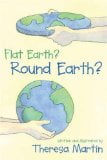 Flat Earth? Round Earth?
Flat Earth? Round Earth?
by Theresa Martin
Prometheus Books, $12, ISBN 1573929883
Two schoolboys argue about the shape of the world. The teacher says it’s a sphere, but Stan says it is round but flat as a pancake. “Look out the window, see for yourself ” is his argument.
Nathan sets out to prove to him the teacher is right and the earth truly is a sphere. He uses all the standard observations, round the globe travel, ship sinking below the horizon, time zonation, different shadow lengths, and the shape of the earth’s shadow on the lunar eclipse. Stan rejects them all. It is a book for children “ages 7 and up.” Arguments and proofs are appropriately simple, so youngsters can follow. The author’s intention is to teach a sceptical attitude, and introduce an understanding of evidence and proof.
Stan’s objections seem invented for the moment. Tales of global travel are made up, different shadow length are explained by a nearby sun, ships sinking are optical illusions, there may be local curvature of the Kansas plain, and a disk shaped earth will throw a circular shadow. The author’s point is that any proof can be denied by ad hoc explanations, but scientific knowledge comes from many directions and several lines of evidence. It is the balance of facts which prove the earth a sphere. The book drives home a single valuable lesson of scientific reasoning, and I think children may like it. They will, however, ask why Stan so stubbornly insists the world is flat? No reason is given. The earth curves only about 8 inches in a mile (about 8 cm in a km), which is not a bad approximation to flat. The only reason I can think of as to why Stan cannot be convinced, but remains stubbornly wedded to a flat earth, is because the Bible says so. The author does not tell us.



